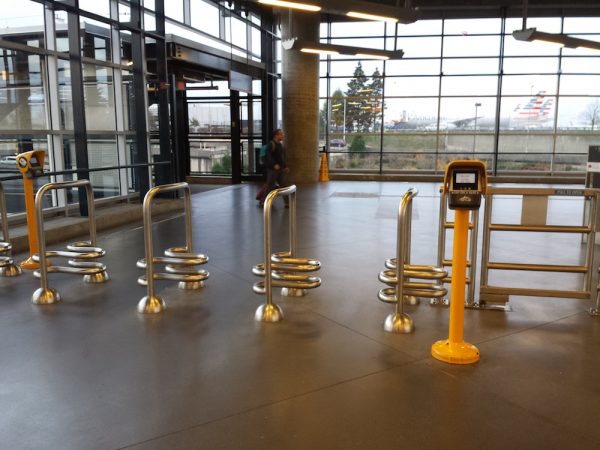Sound Transit Light Rail Stations Need (Visual) Payment Barriers
How many times a day does this happen at Sound Transit's new UW Station? Someone arrives at the station from street level, hops on the elevator, and gets to the platform. As they're about to board the waiting train, they realize that they forgot to pay. There's no ORCA card reader on the platform, so they curse and take the elevator all the way back up to the street to swipe their card (or they get on the train and take their chances without paying if the train is about to leave).
@SoundTransit Hey, are there card readers on the platform at the UW Station?
- Rebecca Nelson (@lilsheba) May 23, 2016
@NEGreenways @SoundTransit Nice station, but why no ORCA pads at platform level? Very inconvenient for riders. Reason?
- elg (@e_gow) October 25, 2016
@soundtransit why is beacon hill the only station without an orca card reader on the platform? you start (cont) http://t.co/batbuoNyeF
- Alexander of Dublin (@hibernian) October 15, 2015
@tpfliss @SoundTransit I've ended up going upstairs and missing the train!
- Daigoro Toyama (@daihard) June 8, 2016
@SoundTransit @NEGreenways I will say that the this lack of barrier has resulted in me eating lots of charges from forgetting to tag off.
- Matt White (@F_WRLCK) October 25, 2016
This issue has resulted in more than a few people asking Sound Transit for ORCA card readers on the train platform. The agency, however, is going in the opposite direction - ORCA readers will disappear from the Downtown Seattle Transit Tunnel platform once buses get kicked out of the tunnel. According to Sound Transit spokesman Bruce Gray, the main reason for not including ORCA readers on platforms is to prevent loitering. Sound Transit wants a clear delineation between Fare Paid areas and the rest of the station. It's also possible they aren't very excited about maintaining extra hardware.
Gray noted that they have "Link Fare Paid Zone" signs at stations. In my experience, however, they're easy to miss. For example, the sign at this UW Station elevator is located above where most people are looking. The ORCA reader is tucked into a corner next to the larger ORCA machines, which is easy to miss for people approaching or exiting from a different side.

UW Station. Photo by the author.
At the Capitol Hill Station, the signs are located above the elevator and escalator. However, the signs face towards people who are entering the station. The view from the escalator as you're exiting the station makes it easy to miss the ORCA readers. No signs are there to remind people to tap their card as they exit, resulting in people forgetting and getting overcharged for their trip. Between the entrance and the platform, there are a fair number of ORCA readers, but when there's a large crowd of people (as is typical when a train arrives and people exit), it's very easy for the readers to not be visible.

Capitol Hill Station. Photo by the author.

Capitol Hill Station. Photo by the author.
Gray indicated that the agency is "looking at ways to make it more clear to riders when they're entering a fare paid zone," but cautioned that it would have to wait until the downtown tunnel is rail-only, sometime in 2018. But we needn't look to far for inspiration. One station in the system already has a model for what a better fare paid zone could look like.
Most other rail transit systems have some form of turnstile before entering onto a train platform, but that would be additional (unnecessary) hardware for Sound Transit to maintain. We don't actually need physical barriers. What would help with this issue is a transition point that reminds people to swipe their ORCA cards. We actually have this sort of thing already at Sound Transit's SeaTac Station, in the form of cart guards.

Cart guards at SeaTac. Photo by the author.
Because they look like a gate or turnstile, these cart guards send a psychological signal to Sound Transit users that they're entering a Fare Paid zone. This signal works much better than any signage ever could. Having this sort of thing in other stations would help remind people to pay before they get to the train platform. It could also remind them to swipe their ORCA cards after leaving the train. It has no moving parts, and requires almost no maintenance other than a fresh coat of paint every half- decade or so.
We should ensure that such a system has enough clearance to allow wheelchairs, strollers, bicycles, and other devices through. Because it only needs to send the visual signal of a barrier, designing something wide enough shouldn't be difficult. So how about it, Sound Transit?